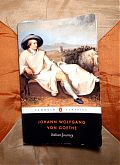
Johann Wolfgang von Goethe
Italian Journey
Two hundred and twenty-five years ago Johann Goethe suddenly set out from Germany to travel to the country that had long lived in his imagination: Italy. He travelled by horse and carriage relatively quickly; on reaching Italy he travelled more slowly, through Verona, Venice, Rome, Naples and Sicily over the course of two years.
Goethe was 37 when he left and had already written The Sorrows of Young Werther, which had made him famous both in Germany and abroad. For some time Goethe had been working for the government in Weimer; he had become complacent: he needed a journey. And like all good adventures, Goethe’s in Italy changed his life. Though his main objective was always to enhance his knowledge, the easy-going Italians, the countryside, its ruins and its art made their own impressions. Indeed, it would be impossible to complete such an undertaking unaffected.
As Goethe’s journey begins, the first thing that struck me about this inexhaustible man was his rampant curiosity in the natural world. He collects rocks for personal geological surveys, hypothesizing about the Earth’s formation. He can identify rocks by sight and is able to deduce what process got them there. Along the way he speculates on the primeval plant, a biological theory he developed. Goethe was part natural scientist. He believed that artists are worthless without some understanding of some higher function of the natural.
It’s no surprise that Goethe experienced Art like Nature.
It is the same in art as in life. The deeper one penetrates, the broader grows the view.
On arriving in Rome, Goethe began what he made the journey to accomplish: he studied, he wanted to learn how to see the visual arts, for which he claimed to have no “eye.” He studied Classical architecture but mainly the statues: the Apollo Belvedere and the Rondanini Medusa were among his favorites. He studied paintings, frescoes and lots of them: Raphael in the Farnesina and the Sistine chapel as well as the works of his friends were the most influential. Goethe wanted to know what makes art; he was relentless.
But how can we, petty as we are and accustomed to pettiness, ever become equal to such noble perfection? Even when one has adjusted oneself in some degree, a tremendous mass of new things crowd in on one, facing one at every step, each demanding the tribute of one’s attention. How is one to find one’s way through?
“Rome is a great school,” he wrote, where careful observation can reap diverse lessons. There is so much in this city that one needs more than a lifetime to understand it, a lifetime to scratch the surface. So when Goethe arrived he began right away, stayed five months, journeyed to Naples and Sicily then returned to Rome for eleven months more.
For further study, Goethe had casts of sculptures made, he commissioned his friends to make drawings and began to draw himself. To always have the object that has struck our curiosity before us, has become second nature with the internet. But back then, reproduction was tedious, heavy and for the rich. To see a photo of Paestum as Goethe describes it brings me deeper into his descriptions, which is why Goethe was such a collector; he wanted to give the experience—as much as he wanted to preserve it—to his friends back home in Germany.
For all the hundreds of years that have passed since Goethe set his feet on this soil, it is perhaps the most enlightening to realize what has not changed. As a German, Goethe found the Italian way of life excruciatingly laid-back and lacking in advanced technology—a sentiment many who move here from more “progressive” places still feel today. And though the Rome Goethe saw has altered, buildings and statues have gone and been replaced, so much is still here, layered within this rich history, like Goethe, who has become another layer.
What valuable eyes to see Rome and Italy through! For anyone wishing to journey to Italy, I highly recommend it.
· · · · · · · · · · · · · · · · · · · ·